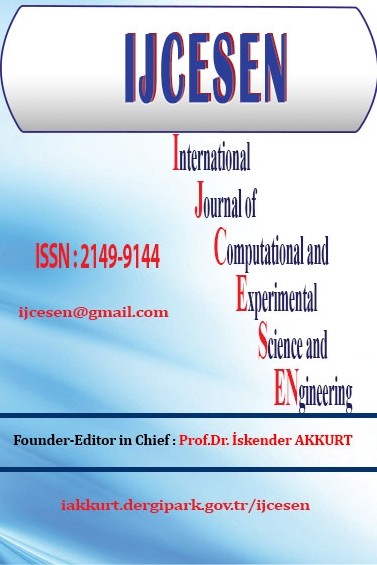Comparison of Bearing Capacity of Piled Raft Foundations Consisting of Different Number of Piles under Static and Repetitive Loads
Comparison of Bearing Capacity of Piled Raft Foundations Consisting of Different Number of Piles under Static and Repetitive Loads
Repetitive load, Static load, Sandy soil, Piled raft foundation,
___
- M. J. Tomlinson, Pile Design And Construction Practice, Chapman And Hall, London, UK, 2004.
- N. Erdemir and V. Okur, Kazık Gruplarının Sismik Etki Altındaki Performansı, Eskişehir Osmangazi Üniversitesi Mühendislik Mimarlık Fakültesi Dergisi. Sayı. 24, No.1, s. 91-107, 2011.
- A. G. Yazici, Kazıklar Arası Mesafenin Kazıklı Radye Temel Sisteminde Etkisinin İki ve Üç Boyutlu Analizi. Yüksek Lisans Tezi, Niğde Üniversitesi, Fen Bilimleri Enstitüsü, Niğde, 75s, 2013.
- T. Whitaker, Some Experiments on Model Piled Foundations in Clay, 6th International Congress of International Association of Bridge Structure Engineering, Stockholm, Sweden, pp. 124-139, 1961.
- H. Kishida, K. Matsushita and I. Sakamoto, Soil-Structure Interaction of the Elevator Tower and Concrete Footings. Proceedings of the 4th World Conference on Earthquake Engineering, Vol. 3, Santiago de Chile, pp 101–115, 1969.
- A. Tejchman, Model Investigation of Pile Groups in Sand, Journal of the Soil Mechanics Foundation Division, ASCE, USA, Vol. 99, No. SM2, 199–217, 1973.D. L. York and R. J. Leahy, Experiences with Heave and Relaxation of End Bearing Piles. Associated Pile and Fitting Corp. Pile Talk Seminer, New York, pp. 73-85,1979.
- R. W. Cooke, Piled Raft Foundations on Stiff Clays-A Contribution to Design Philosophy, Géotechnique, Vol. 36, No:2, pp. 169-203,1986.
- D. D. Sönmez, Orta Sıkılıktaki Kumdaki Kazık Gruplarının Negatif Sürtünmesi ile İlgili Bir Model Çalışma, Yüksek Lisans Tezi, Orta Doğu Teknik Üniversitesi, Fen Bilimleri Enstitüsü, Ankara, 89s,1994.
- N. F. Ismael, Axial Load Tests on Pile and Pile Group in Cemented Sands, Journal of Geotechnical and Geoenvironmental Engineering. pp 767-773, 2001.
- R. Butterfield and P. K. Banerjee, The Problem of Pile Group-Pile Cap Interaction, Géotechnique, Volume 21, No:2, pp. 135-142, 1971.
- F. Kuwabara, An Elastic Analysis for Piled Raft Foundations in Homogeneous Soils, Soils and Foundations, Vol. 29, No:1, pp. 82-92,1989.
- M. U. Ergun ve H. K. Türkmen, Kazıklı Radye Temellerin Etkin Tasarımı. 103I007 nolu Tübitak Projesi, Ankara, 2007.
- D. D. C. Nguyen, S. B. Jo and D. S. Kim, Design Method of Piled-Raft Foundations Under Vertical Load Considering Interaction Effects, Computers and Geotechnics, Vol. 47, pp. 16-27, 2013.
- TS 1500, İnşaat Mühendisliğinde Zeminlerin Sınıflandırılması.
- S. Gök, Kazıklı Radye Temellerin Analizi. Doktora Tezi, İstanbul Teknik Üniversitesi, Fen Bilimleri Enstitüsü, İstanbul, 101s, 2007.
- Yayın Aralığı: 4
- Başlangıç: 2015
- Yayıncı: Prof.Dr. İskender Akkurt
Effect of Stress Sensitivity on Production of Tight Heterogeneous Reservoir
Thermal Analysis of a Zirconium Dioxide Coated Aluminum Alloy Piston
Murat OZSOY, İsmet TIKIZ, Hüseyin PEHLİVAN
Baki BAĞRIAÇIK, Sefer Ercan EPSİLELİ, Emre PINARCI, Mustafa BELEN
Characterization of Hydroxyapatite Coating on Ti6Al4V by Sol-gel Method
Gür Emre GÜRAKSIN, Eyüp Can BİÇER, Atilla EVCİN
Internet Based Data Collection and Analysis of Objects in Solar Energy Production Systems
Study on performance of progressing cavity pumps (PCPs) in different fit modes
Lei ZHENG, Xiaodong WU, Ruidong ZHAO, Huachang LI, Mengyun LIU
Resistivity and Seismic Refraction Studies on Kısıklı Landslide (Antalya, Turkey)
Reduction of Ship Based CO2 Emissions from Container Transportation
Ayfer ERGİN, Mustafa Fatih ERGİN
Xueli GUO, Jun LI, Gonghui LIU, Hui YAN
